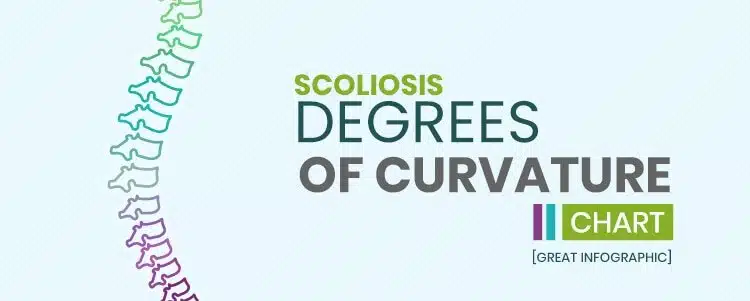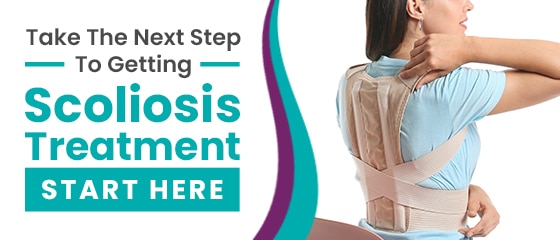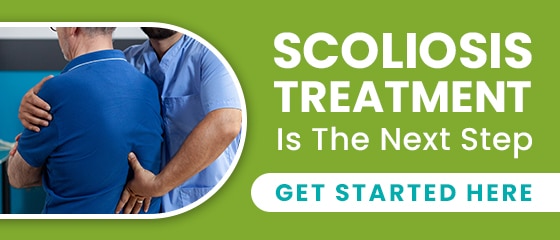There are not only many different forms of scoliosis, but also different severity levels and approaches to treating them. Cobb angle is a measurement, expressed in degrees (via X-ray), that determines how scoliosis is classified on the severity scale. The higher the Cobb angle, the more severe the condition is, and this is the main variable that guides the chosen treatment plan moving forward.
The accompanying chart provides a great visual to augment an understanding of the varying levels of scoliosis severity and corresponding treatment options: traditional and functional. Let’s take a look at various degrees of scoliosis curvatures and how a traditional and functional treatment approach would respond at each level, first for adolescents, and then for adults.
How Much of a Curve is Considered Scoliosis?
If a healthy spine is viewed from either side, it will take on a soft ‘S’ shape, and when viewed from the front and/or back, it will appear straight, and this is because of the spine’s natural and healthy curves.
Healthy spines are curved naturally at each of the spine’s main sections: the cervical spine (neck), the thoracic spine (middle/upper back), and the lumbar spine (lower back).
If a healthy spine has its natural and healthy curves in place, its vertebrae are aligned in a straight and neutral position as they should be, but when a curve becomes under- or over-pronounced, this becomes problematic.
In addition, there are problematic spinal curves that bend unnaturally to the side and also twist; this is scoliosis, and scoliosis is a highly-prevalent spinal condition that warrants awareness, especially because it’s most commonly diagnosed in children.
What Makes a Scoliotic Curve Different?
A scoliotic curve doesn’t just bend unnaturally to the side, it also twists from front to back and back to front, and this rotational component is what makes scoliosis a complex 3-dimensional condition.
So for an unnatural spinal curve to be considered a true scoliosis, it has to bend to the side excessively, twist unnaturally, and it also has to meet a minimum size requirement: Cobb angle measurement of at least 10 degrees.
A Dr. William Kane called for a diagnostic cutting-off point to establish consistency among different treatment providers and care facilities back in the ‘70s, and 10 degrees is still the minimum size requirement used to diagnose scoliosis today.
A patient’s Cobb angle is a measurement determined during X-ray; not only does it tell me how far out of alignment a scoliotic spine is, it also classifies conditions in terms of severity, and this is a key condition factor that treatment plans are shaped around.
A Cobb angle measurement involves drawing lines from the tops and bottoms of the curve’s most-tilted vertebrae, and the intersecting lines form an angle that’s expressed in degrees.
The higher a patient’s Cobb angle, the larger the scoliotic curve is, the more severe the condition, and the more likely it is that its effects are going to be noticeable:
- Mild scoliosis: Cobb angle measurement of between 10 and 25 degrees
- Moderate scoliosis: Cobb angle measurement of between 25 and 40 degrees
- Severe scoliosis: Cobb angle measurement of 40+ degrees
- Very-severe scoliosis: Cobb angle measurement of 80+ degrees
Another condition feature that makes a scoliotic curve different is that as a progressive condition, the nature of scoliosis is to get worse over time, and that means that the size of the unnatural spinal curve, the condition’s uneven forces, and their effects are virtually guaranteed to increase.
So the size of a scoliotic curve when it’s first diagnosed doesn’t mean that’s where it will stay, especially if left untreated, not treated proactively, and/or in severe cases.
The scoliosis degrees of curvature chart illustrates varying degrees of spinal curvature, ranging from mild, such as 5 or 8 degrees scoliosis, to more severe cases like 24-degree scoliosis, which may require different interventions such as physical therapy, particularly in conditions like adolescent idiopathic scoliosis or congenital scoliosis.
When an unnatural spinal curve is diagnosed as scoliosis, how that diagnosis is responded to with treatment is key because as a progressive condition, it’s likely to get more severe and complex to treat over time, and while there are never treatment guarantees, there are a number of benefits associated with early detection and intervention.
Adolescent Scoliosis Degree of Curvature
Adolescent idiopathic scoliosis (AIS) is by far the most common form of the condition and is diagnosed between the ages of 10 and 18. It makes up 80 percent of diagnosed cases in the United States.
As it’s classified as ‘idiopathic’, we can’t isolate one single known cause for its development, but we know it has a lot to do with growth/development and spinal tension.
A large component of treating AIS is monitoring for progression, as growth and development are the big trigger. Treatment responds to growth and progression in different ways, depending on which approach a patient chooses to follow.
Referring to the accompanying chart, let’s take a look at each level of the condition based on degree of curvature, and how each of the two main treatment approaches would respond.
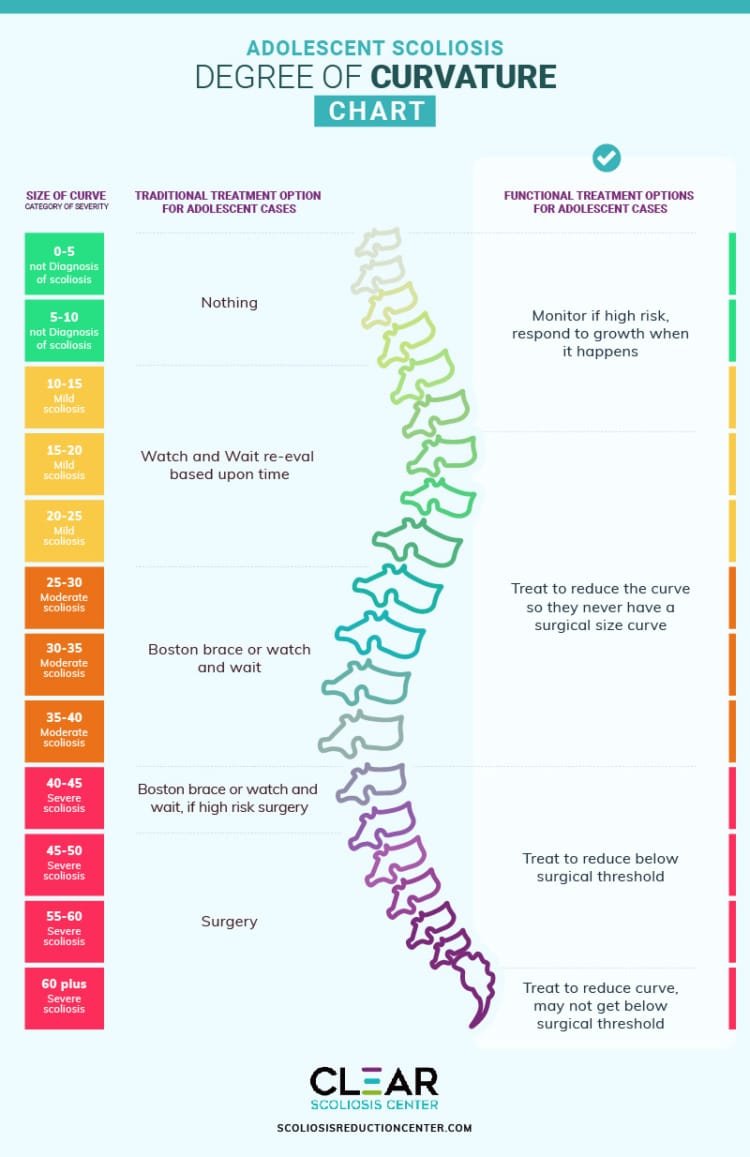
A Scoliosis Diagnosis
A Scoliosis diagnosis is given when an abnormal curvature is measured at 10+ degrees and includes rotation, which is what makes scoliosis a 3-dimensional condition.
Traditional treatment: even at a 10, 15, or 20 degree of curvature, typically, no active treatment is started. If anything, the watch-and-wait approach will be initiated here to passively observe.
Functional treatment: in the functional approach, active treatment is started as close to the time of diagnosis as possible, as early intervention is one of the keys to treatment success.
Even at 10 degrees, a functional approach would involve a customized combination of therapy, rehab, exercises, and chiropractic.
At this stage, as the patient’s age puts them at the highest risk for progression, monitoring is also an important component of treatment. The goal is to always stay ahead of progression, which is why we order X-rays frequently to observe how the spine is responding to treatment/growth and assess how the treatment disciplines should be apportioned.
Mild Scoliosis in Adolescents
At a Cobb angle measurement of 10 – 25 degrees, this is classified as ‘mild scoliosis’. This is, again, where the ideologies governing each of the main treatment approaches differ greatly.
Traditional treatment: in the traditional approach, the reaction is passive. A patient would be told that as the condition is mild, it should be observed to see how/if it progresses.
The patient would likely be told to return in 3, 6, or 12 months (depending on the patient’s age) for another series of X-rays and to re-evaluate.
Functional treatment: in the functional approach, I believe this is precisely the time to act, before the condition progresses in severity.
I would continue our proactive treatment plan based on the information provided by the patient’s scoliosis X-ray, including the location of the curvature, causation (if known), and most importantly, the degree of curvature.
As a progressive condition, virtually every patient’s scoliosis is going to progress, at varying rates, so I don’t see a point to watching and waiting; I see this as wasting valuable treatment time.
My integrative approach would work towards reducing the curvature to prevent it from ever reaching surgical levels.
Here at the Scoliosis Reduction Center®, even when a patient’s condition is mild, we start working towards achieving a curvature reduction. We also continue monitoring how the patient’s spine is responding to treatment and growth: tweaking that plan as needed to address how the patient’s spine is responding.
Moderate Scoliosis in Adolescents
At a Cobb angle measurement of 25 – 40 degrees, this is classified as ‘moderate scoliosis’.
Traditional treatment: along the traditional treatment route, two likely responses to this moderate degree of curvature would be continuing to watch and wait, or using a traditional scoliosis brace (Boston brace) in an attempt to stop the condition from progressing further.
The Boston brace is the most commonly-used brace in the United States. This brace has to be worn virtually all the time (18 – 23 hours a day), and as you can imagine, compliance with this is a big challenge.
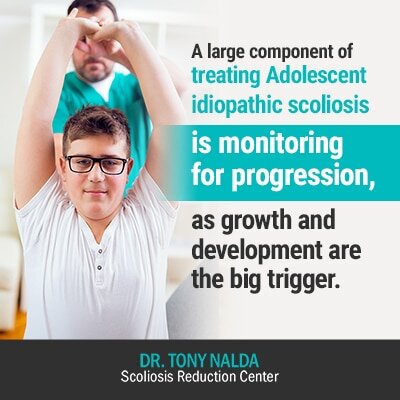
The Boston brace is cumbersome, uncomfortable, and does not work towards ‘correcting’ the abnormal curvature, but merely attempts to stop the condition from getting worse.
Functional treatment: at 25 – 40 degrees, we continue working to reduce the curvature, addressing the underlying structural nature of the condition, with the ultimate goal of correction and prevention; this is done through achieving a curvature reduction/supporting and stabilizing the spine, and preventing the condition from reaching more severe levels and preventing the need for future surgery.
As an abnormal spinal curvature increases, we adjust our treatment plan by apportioning our treatment disciplines in response. The goal is to try and stay ahead of the condition’s progressive nature.
The scoliosis degrees of curvature chart helps in understanding the severity of conditions such as a 11 degrees scoliosis, 36-degree scoliosis, levocurvature, and dextrocurvature, and it provides guidance on what degree of scoliosis requires surgery, while highlighting the encurve side effects associated with lateral curvature of the spine in both the thoracic and lumbar spine regions.
Severe Scoliosis in Adolescents
At a Cobb angle measurement of 40 – 60+ degrees, we are into the ‘severe scoliosis’ classification. At this stage, postural changes can become very noticeable, and the potential for causing related adverse symptoms is increased.
Traditional treatment: with severe scoliosis, the two earlier responses of watching and waiting or using a Boston brace to stop progression would be continued.
This is also the stage that funnels patients towards spinal-fusion surgery as their condition approaches a surgical-level curve at 45 – 60+ degrees.
If a patient is at high risk for continued progression, spinal fusion is often recommended as the best treatment option.
Spinal fusion, however, is invasive and carries heavy side effects and numerous risk factors.
Functional treatment: at the 40 – 60+ degree range, we could continue our integrative approach to treatment in an effort to reduce the patient’s degree of curvature below surgical-curve level. This would include a continued combination of chiropractic adjustments, rehabilitation, at-home exercises, and corrective bracing.
In the functional approach, a different level of bracing is used: the corrective ScoliBrace. The ScoliBrace doesn’t just work towards slowing/stopping progression, like the Boston brace, but actually correcting the abnormal spinal curvature. It is 100-percent customized to suit the patient’s body and condition, making it far more comfortable to wear and lessening the compliance issue.
Our main goal, at this stage, is not only to correct a patient’s abnormal curvature as much as possible, but to help them avoid spinal-fusion surgery and all the heavy risk factors and potential side effects that go along with it.
If a patient’s curve still progresses to the end of that range at 60+ degrees, we continue working towards a curvature reduction, lessening symptoms, and avoiding spinal-fusion surgery.
Adult Scoliosis Degree of Curvature
While scoliosis is far more commonly diagnosed during adolescence, adults are also diagnosed with the condition.
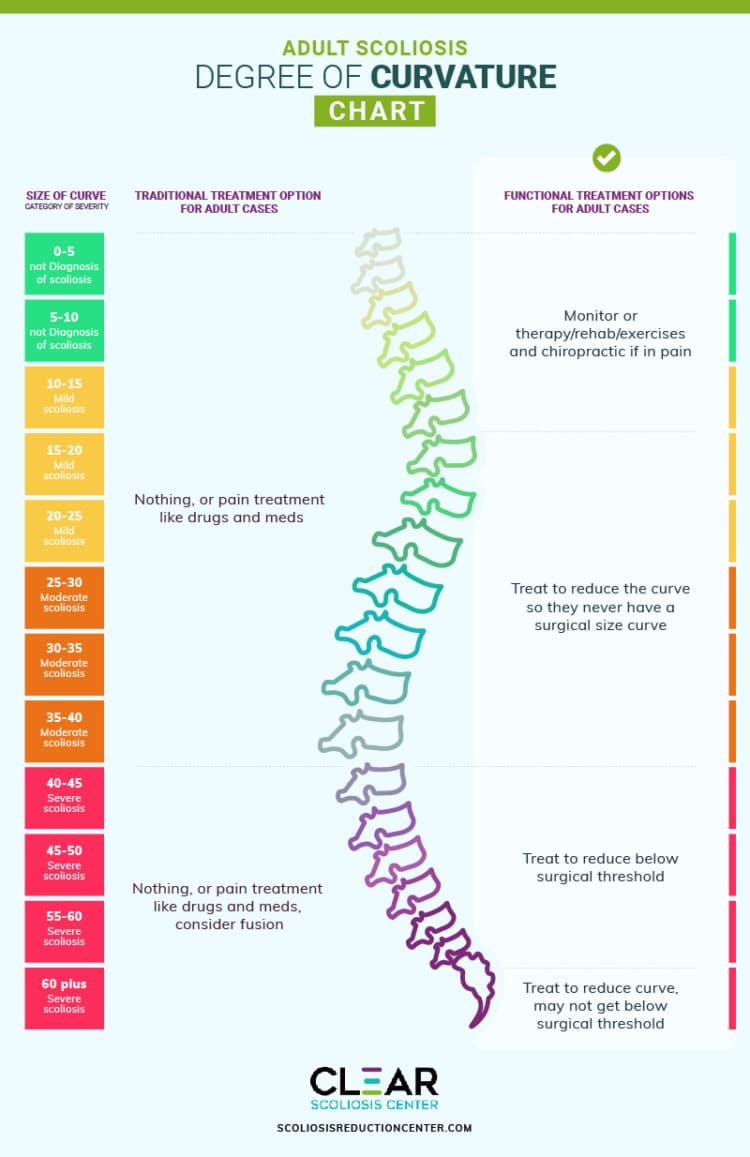
Adult scoliosis has two main forms: idiopathic and degenerative. Idiopathic scoliosis in adults is a continuation of AIS that went undiagnosed during adolescence until it, most likely, starting producing noticeable symptoms in adulthood.
This is commonplace because, as you can see from the accompanying chart, scoliosis develops across a wide spectrum of severity; in addition, scoliosis in adolescents is rarely a painful condition, making early detection challenging.
In degenerative scoliosis, this form is most common in adults over the age of 40. As a person moves into the later stages of life, the spine, like the rest of the body, faces degenerative changes, most commonly affecting the discs of the spine.
As adults have the big trigger for progression (growth) removed, by reaching skeletal maturity, progression tends to slow down; however, over time, the cumulative effects of slow progression can also be significant, resulting in a large degree of curvature.
A Scoliosis Diagnosis
The same as in adolescent scoliosis, a diagnosis is given if a patient’s abnormal spinal curvature has a Cobb angle measurement of 10+ degrees and includes rotation, making it a 3-dimensional condition.
Traditional treatment: even at a 10, 15, or 20 degree of curvature, typically, no form of treatment will be started. Instead, the watch-and-wait approach will be advised to passively observe how/if the condition progresses.
Functional treatment: active treatment is started as close to the time of diagnosis as possible. Even with a minor curvature of 10 degrees, a functional approach would start with designing a customized treatment plan by combining scoliosis-specific therapy, rehabilitation, exercises, and chiropractic.
Monitoring the patient for progression would be another important component of early treatment.
Mild Scoliosis in Adults
At a Cobb angle measurement of 10 – 25 degrees, this is considered ‘mild scoliosis’, and depending on what treatment approach a patient chooses, active treatment can be started, or delayed, during this stage.
Traditional treatment: at a 10 – 25 degree of curvature, active treatment is not started. Medications to deal with pain can be prescribed, but this is not treating the actual scoliosis, but rather a symptom of it.
Typically, pain is far more commonly a part of the scoliosis experience in adults, which is why pain management is such a big part of treating adult scoliosis.
Functional treatment: at a 10 – 25 degree of curvature, we would continue monitoring the patient for progression and related symptoms.
We would continue our combination of scoliosis-specific therapy, exercise, and chiropractic to address any pain and discomfort in a less invasive and more effective way. It is in this stage that we could decide to introduce corrective bracing into the treatment plan.
Depending on how we see the spine responding to treatment, we would tweak the plan and approtion the different disciplines according to the needs of the patient and their condition.
With functional treatment at this stage, the goal is to address the underlying structural nature of the condition by working towards a curvature reduction and lessening related symptoms, such as pain, along with it.
Moderate Scoliosis in Adults
At a Cobb angle measurement of 25 – 40 degrees, this degree of curvature is classified as ‘moderate scoliosis’.
Traditional treatment: at a 25 – 40 degree of curvature, those following the traditional treatment approach would still not be engaged in active treatment; instead, continued pain medications/injections would likely be prescribed to deal with any scoliosis-related pain or discomfort.
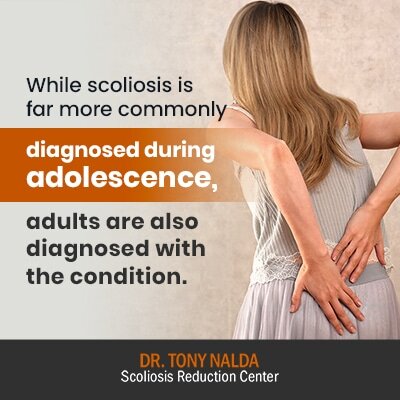
Functional treatment: at a 25 – 40 degree of curvature, we would be actively working towards reducing the curvature as much as possible, while observing how the spine is reacting and adjusting our treatment tools of chiropractic, therapy, rehabilitation, and corrective bracing accordingly.
By engaging in active treatment, we would not only be treating the condition’s symptoms, such as pain, but also the underlying condition, first and foremost, by working towards a structural change.
Severe Scoliosis in Adults
At a Cobb angle measurement of 40 – 60+ degrees, this is classified as ‘severe scoliosis’.
Traditional treatment: this might seem surprising, but even with a 40 – 60+ degree of curvature, treatment would still consist of medications to address symptoms.
It’s at this level that patients are funneled towards spinal-fusion surgery as it becomes clear that their scoliosis is continuing to progress and is likely that related symptoms and pain will continue to get worse.
Functional treatment: at 40 – 60+ degrees, our goal is to stabilize the spine and reduce the curvature degree to below the surgical threshold.
We also address symptoms by continuing to reduce the patient’s curvature to where it was prior to when they started to experience pain and discomfort; then we work towards sustaining that reduction to keep those symptoms at bay and avoid the need for spinal-fusion surgery.
Conclusion
When a patient, adolescent or adult, is diagnosed with scoliosis, they can be faced with many emotions. Questions of how it will affect their lives and how bad it can get are common responses.
While there is no right or wrong way to react, it’s important to have a full understanding of the condition itself, as well as potential treatment options.
When it comes to treating scoliosis, there are two main treatment approaches: traditional and functional. The former is based on a passive reaction that tends to funnel patients towards spinal-fusion surgery; the latter is what we are proud to offer our patients here at the Scoliosis Reduction Center®.
With our functional treatment approach, we start active treatment, for both adolescents and adults, as close to the time of diagnosis as possible. While adolescent and adult scoliosis differ greatly in terms of experience and treatment, they share a correlation between active treatment started early and treatment success.
Scoliosis severity is a big component when it comes to deciding on a treatment plan, and scoliosis degrees of curvature classify a condition as mild, moderate, or severe.
As a progressive condition with no known cure, it’s important to address each stage of the condition with active treatment, in an attempt to prevent it from progressing in severity and reaching that surgical-level threshold.
